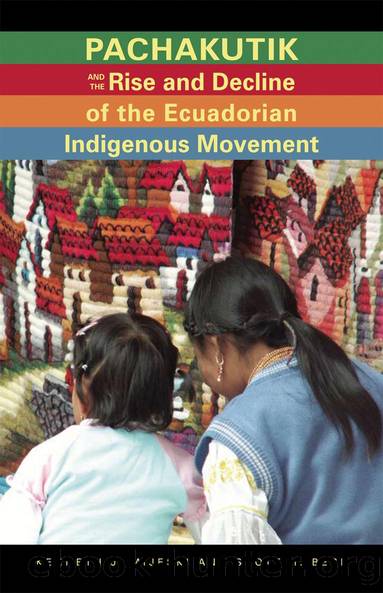Pachakutik and the Rise and Decline of the Ecuadorian Indigenous Movement by Kenneth J. Mijeski Scott H. Beck

Author:Kenneth J. Mijeski, Scott H. Beck [Kenneth J. Mijeski, Scott H. Beck]
Language: eng
Format: epub
Tags: History, Latin America, General, Political Science
ISBN: 9780896804777
Google: x_NHBAAAQBAJ
Publisher: Ohio University Press
Published: 2011-03-08T00:39:53+00:00
EI Analysis of the 2002 Elections
Did the majority of indigenous voters follow the CONAIE-Pachakutik line and vote for Lucio Gutiérrez in the first round of the 2002 presidential election? Was the support by indigenous voters, as widely claimed, actually crucial to the electoral success of Gutiérrez? Did the majority of indigenous voters cast ballots for Pachakutik or Pachakutik-in-alliance candidates for Congress? We will address these questions through the use of the ecological inference method (EI). While some additional data and analytic issues have to be addressed with the 2002 elections, our basic purpose once again is to estimate the proportion of indigenous, and nonindigenous, voters who supported the Pachakutik movement.
The 2002 election results were made publicly available on a CD-ROM by the TSE in early 2003, with complete results down to the level of the parroquia. By early 2004, INEC, the Ecuadorian census bureau, had made available on its Web site the complete results of the 2001 national census, also down to the parroquia level. The self-identification item on the census revealed a low number of indÃgenas, approximately 7 percent. It is unlikely that this is accurate, though there is no way to know how much of an underestimate it is, and we actually prefer the SIDENPE data that was previously described and used in analyzing the 1996 and 1998 election results (see chapter 4). Because it is an official estimate of the Ecuadorian government, is more recent than the SIDENPE estimate (which was based on 1995 data), and has been used by other analysts, we will use the census data on the proportion of the population that is indigenous. However, we will also use the SIDENPE data and compare the results of the two.
Because all three sources of data were available at the parroquia level, it was decided to carry out the analysis at this more specific level of aggregation, especially since it will allow us to incorporate regional variation into the analysis. A problem in using the parroquia-level data is that those listed in the INEC and SIDENPE data sets do not always match up with the parroquias listed in the TSE data on vote totals. Basically, in the INEC and SIDENPE data, especially the latter, not all urban parroquias are listed. Rather, some are combined in confusing ways. In the TSE data there are 1,166 parroquias listed but they can be matched with only 984 in INEC and 946 in SIDENPE. In many cases we were able to combine urban parroquias in the TSE data to match INEC and SIDENPE cases and consequently in both data sets approximately 98 percent of the electorate is included.8 Furthermore, the vote totals in our data set are virtually the same as the official electoral results for the whole nation. For example, according to the TSE data, the percentage of valid votes received by Gutiérrez in the first round was 20.64. In our data, once each parroquia is weighted, the percentage of valid votes for Gutiérrez in the SIDENPE data is 20.
Download
This site does not store any files on its server. We only index and link to content provided by other sites. Please contact the content providers to delete copyright contents if any and email us, we'll remove relevant links or contents immediately.
| Argentina | Bolivia |
| Brazil | Chile |
| Colombia | Ecuador |
| Guyana | Paraguay |
| Peru | Suriname |
| Uruguay | Venezuela |
Cat's cradle by Kurt Vonnegut(13919)
Pimp by Iceberg Slim(12964)
Underground: A Human History of the Worlds Beneath Our Feet by Will Hunt(11283)
4 3 2 1: A Novel by Paul Auster(11092)
The Radium Girls by Kate Moore(10937)
American History Stories, Volume III (Yesterday's Classics) by Pratt Mara L(4831)
Perfect Rhythm by Jae(4636)
Wiseguy by Nicholas Pileggi(4620)
The Fire Next Time by James Baldwin(4360)
Paper Towns by Green John(4186)
A Higher Loyalty: Truth, Lies, and Leadership by James Comey(4049)
Pale Blue Dot by Carl Sagan(4029)
The Mayflower and the Pilgrims' New World by Nathaniel Philbrick(3924)
The Doomsday Machine by Daniel Ellsberg(3745)
Too Much and Not the Mood by Durga Chew-Bose(3706)
Killers of the Flower Moon: The Osage Murders and the Birth of the FBI by David Grann(3638)
The Borden Murders by Sarah Miller(3600)
The Sympathizer by Viet Thanh Nguyen(3537)
Killing England by Bill O'Reilly(3471)
